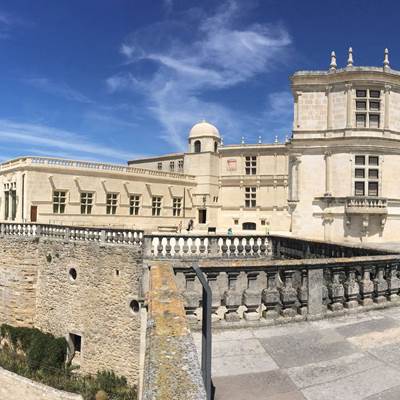
The Chauvet Cave 2 Discovering the first great masterpiece of humanity
24 Dec 24Where is the Chauvet cave?
Located on a limestone plateau crossed by the meanders of the Ardèche River, in the south of France , the cave contains the oldest paintings known to date (Aurignacian period: between 30,000 and 32,000 BC).
What animals are represented on the walls of the Chauvet cave?
The 430 animals represented belong to 14 species, which is unusual: mammoths, rhinoceroses, lions, bison horses, aurochs, ibex, bears, reindeer, deer, megaceros deer, musk oxen, panther, owl and perhaps hyena . The cave bear frequented the site well before Man and just after him.
How old is the Chauvet cave?
36,000 years
Listed as a UNESCO World Heritage Site, the Chauvet Cave contains drawings of exceptional quality dating back 36,000 years .

The Saint-Paul-Trois-Châteaux retail truffle market,
24 Dec 24You are here, on the lands where nature fertilizes the Truffle »
Born from the will of a handful of truffle growers proud to take the Truffle out of its almost too secret universe, the Market is aimed at individuals wishing to discover and taste the finest quality Truffles. Each Truffle Grower reserves his finest Truffles dug during the week to submit them to the Control Commission gathered before the opening of each Market. The approved Truffles will then be put on sale on the market.
There are two types of truffle markets: The "" Wholesale Market""» and the « retail market ». At wholesale markets, truffle growers sell their batches of truffles to brokers. For several years now, there have been retail markets , such as the one in Saint-Paul-Trois-Châteaux, where truffles are sorted and sold directly to individuals .
The canton of Saint-Paul-Trois-Châteaux and those of Grignan and Valréas is the leading truffle production area in France.
The Saint-Paul-Trois-Châteaux Truffle Market selects truffle growers and checks each truffle offered before sale!
Market values
Loyalty
Sincerity
Honesty
Quality
Sharing
Certain origin
The partners
Truffle growers have registered their desire for transparency on the origin, variety and quality of each Truffle . Restaurateurs, accommodation providers (hotels, guest houses, etc.) have joined them and signed the market quality charter . They organize meals , stays , tastings , meetings (Truffle growers, digging sessions, Truffle and Wine pairings, etc.). Also partners: the Tourist Office, the Brotherhood, the Remarkable Site of Taste, the House of Truffles and Tricastin, the Winegrowers, the Professionals of perfume plants, etc. all unite around our Black Diamond.

Grignan and its castle
28 Jan 23The history of Grignan is most often confused with the history of its castle and its successive residences.
The castral town, mentioned as early as 1105, developed in the 13th and 14th centuries, with the growing role of the powerful Adhémar de Monteil family, whose younger branch (the Adhémar de Grignan), would definitively own the seigneury from 1239.
The village, nestled at the foot of its castle, remained sheltered within its walls until the very end of the 15th century.
The first extension of the agglomeration will take place in the middle of the 16th century, with the creation of the large and small suburbs, the promenade and games of the Mail (1550), and the construction, outside the walls, of the grain hall (1553 ), at the current location of the town hall.
The construction of the Saint-Sauveur collegiate church (1535-1542) and the major embellishment work on the castle (1543-1557) which transformed the old medieval fortress into a sumptuous Renaissance palace still date from this same period.
The town and its castle will experience other hours of glory in the 17th century with François de Castellane Adhémar, Count of Grignan, who for nearly half a century exercised the functions of lieutenant general and governor of Provence.
His marriage to Françoise Marguerite de Sévigné in 1669 was the origin of the famous epistolary correspondence exchanged between the Marquise de Sévigné and her daughter, the Countess of Grignan.
From the 18th century, the memory of Madame de Sévigné and her rising literary glory saved the Château de Grignan from ruin and oblivion.
The modernization of the village in the 19th and 20th centuries accompanied economic development, while preserving the richness of its architectural heritage and the quality of its landscapes.

The Crocodile Farm in Pierrelatte
15 Jan 23The Crocodile Farm is a French zoological park located in the Drôme, in Pierrelatte. It consists of an 8,000 m2 greenhouse and a 4,000 m2 outdoor area, where you can observe more than 350 specimens of crocodilians: Nile crocodiles, alligators, caimans, etc., as well as turtles , monitor lizards and snakes.
In addition to its tourist aspect, this farm created in 1994 by Luc and Eric Fougeirol, actively participates in the conservation and protection of species by collaborating with scientists.
https://www.lafermeauxcrocodiles.com/infos-pratiques/tarifs.html

Châteauneuf-du-Pape - Activities in the heart of the vineyard
14 Jan 23Located in Provence, in the department of Vaucluse, our territory extends over the municipalities of Caderousse, Châteauneuf-du-Pape, Courthézon, Jonquières and Orange.
Ideally located, close to Avignon, we benefit from a cultural dynamism. Our small Provençal villages have kept their typical characteristics, allowing visitors to discover the authentic image of Provence.
The AOC Châteauneuf-du-Pape, the first AOC created in France, offers many activities to visitors wishing to know its wines: tastings, visits to estates, food and wine pairings, discovering the vineyard on foot, by bike, etc. We invite you to discover the many activities to practice as a couple, with friends,... in order to discover our magnificent vineyard in a fun way.
the Gorges of the Ardèche
14 Jan 23The Gorges de l'Ardèche are an unmissable place, a natural site of great beauty, in a particularly preserved environment. Lovers of nature activities, escape or simple discovery will be won over by the Gorges de l'Ardèche.
The Ardèche Gorges by Canoe
If you only have to do one canoe descent in your life, it is the Gorges de l'Ardèche, as the spectacle is grandiose and the environment remarkable.
The descent of the Gorges de l'Ardèche by canoe or kayak is accessible provided you respect a few prerequisites: Be in good physical condition, know how to swim, respect the safety instructions and ensure that the conditions for descent of the Gorges are good .
Upstream of the Gorges de l'Ardèche, many service providers rent canoes or kayaks and take care of picking you up at the end of your descent.
The descent of the Gorges de l'Ardèche takes about thirty kilometers, in one or two days.
Two bivouac areas exist and allow you to "camp" in the middle of the Ardèche Gorges, knowing that wild camping (outside these areas) is strictly prohibited.
Even if the water of the Ardèche is often calm and clear, the Gorges de l'Ardèche have no less than fifteen rapids, hence the importance of not leaving your life jacket.



